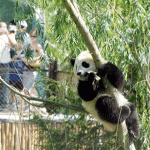
Additional Resources
Read about the Asia Trail here, including video from the Panda Cam. For more informaton regarding the the Smithsonian National Zoo, please visit their website. Read about Emory Knoll Farms in The Greenroof Directory here. Contact information for design team: Jonathan Penndorf, AIA, LEED AP, Chatelain Architects, p.c., 3516 Connecticut Avenue NW, Washington, DC, 20008; 202.244.0243; jpenndorf@chatelainarchitects.com
The National Zoological Park includes conservation of the natural environment as part of its mission statement, so it is fitting that new animal holding facilities in the Asia Trail complex be topped with green roofs. Three facilities are completely covered by green roof systems on Asia Trail: the Sloth Bear Holding Building, the Otter Holding Building, and the Bamboo Storage Shed. The green roofs were included for form and aesthetic. They help to reduce stormwater runoff on the sloped site and add valuable insulation to the buildings. They also help to “camouflage” the buildings so the visitors do not notice them as much when walking the Asia Trail. Asia Trail won the 2006 Presidential Citation for Sustainable Design from the DC Chapter of the American Insitute of Architects. Other sustainable design features include: Solar Hot Water Systems, Naturing Paving Material, Maximizing Daylight, Ipe Wood, Bamboo, Reused, Recycled, and Greener Materials, Energy Star, and Natural Insulation.
The green roof assemblies were designed primarily by the architect (for the roofing system) and the landscape architect (growing medium and plants). The roofing materials installed including Henry roofing products (Henry hot-applied roofing membrane 890-11 and DBR Root Block water retention/root barrier). Atop the hot-applied membrane, 4″ of rigid insulation was installed, then the water retention mat/root barrier, and then the growing medium. Sta-Lite planting medium was specified and approved for use. On the Bamboo Storage Shed, approximately 12″ (305 mm) of planting medium was placed over the assembly, and Humulis Bamboo was planted.Among the best recognized?but rarest?animals in the world, they have come to symbolize endangered species and conservation efforts. As few as 1,600 giant pandas survive in the mountain forests of central China. Another 120 are in Chinese breeding facilities and zoos, and about 20 live in zoos outside China. Giant pandas Mei Xiang and Tian Tian are at the National Zoo on a ten-year loan from the China Wildlife Conservation Association. They are the focus of an ambitious research, conservation, and breeding program designed to preserve this endangered species. Baby cub Tai Shan was born at the National Zoo on July 9, 2005, and is is Mei Xiang and Tian Tian’s first offspring. Adopt a Giant Panda here.
 Greenroofs.comConnecting the Planet + Living Architecture
Greenroofs.comConnecting the Planet + Living Architecture











